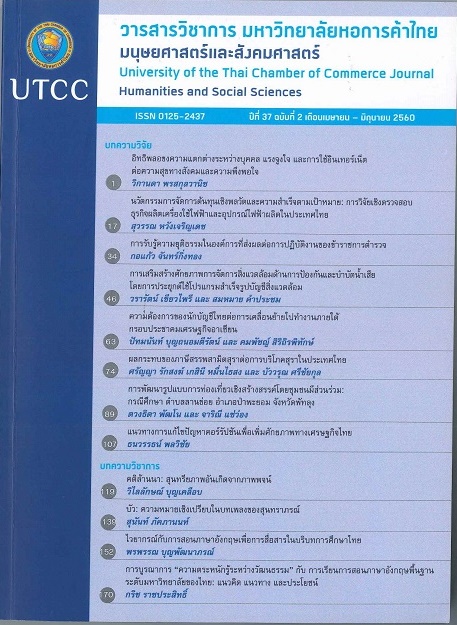Creative Tourism Model Development through Local Participation: A Case Study of Lan Khoi Sub-district, Pa-Phayom District, Patthalung Province
Main Article Content
Abstract
The purposes of this research were 1) to study tourism resources and local wisdom related
to tourism potential of Lan Khoi Sub-district, Pa-Phayom District, Phatthalung province, Thailand;
2) to develop creative tourism model based on local participation; and 3) to create tourism routes
for creative tourism within the area. This research was qualitative in nature. Data were collected
using interview, group conversation, community survey, and group discussion with representatives
from government organizations, Lan Khoi Municipality, tourism entrepreneurs, local leaders, local
occupational groups, and local people. Results revealed that Lan Khoi’s tourism resources are
abundant and can be classified into four categories: history of the community; traditions and
festivals conducive to tourism; local products for tourists; and wonderful tourism attractions. In
terms of the local wisdom for occupations, it was found that no practices were transferred to the
new generation. With regard to the development of creative tourism model in Lan Khoi, tourism
attractions, housewife groups, occupational groups could be of great use, and the emphasis should
be placed on tourism activities through learning and giving them a trial. For example, the weaving
of Lan Khoi cloth, making shadow puppets, and getting to learn about local herbs. Ultimately, these
activities would generate tourist interactions with local people and the tourists would be ableto gain authentic experiences. Finally, three linking routes leading to various tourism attractions were constructed. The routes are expected to provide easy access to tourism attractions and
enhance tourists’ involvement in all kinds of creative tourism activities.
Article Details
ลิขสิทธิ์ของบทความ
ผลงานที่ได้รับการตีพิมพ์ถือเป็นลิขสิทธิ์ของมหาวิทยาลัยหอการค้าไทย ห้ามมิให้นำเนื้อหา ทัศนะ หรือข้อคิดเห็นใด ๆ ของผลงานไปทำซ้ำ ดัดแปลง หรือเผยแพร่ ไม่ว่าทั้งหมดหรือบางส่วนโดยไม่ได้รับอนุญาตเป็นลายลักษณ์อักษรจากมหาวิทยาลัยหอการค้าไทยก่อน
References
Chantavanich, S. (2004). Qualitative research methods.Bangkok, Thailand: Chulalongkorn University. (in Thai)
Chiarakul, T.(2013). Thai business prepartions under the 2011-2015 ASEAN strategic plan for tourism. University of the Thai Chamber of Commerce Journal, 33 (3), 127 - 142. (in Thai)
choibamrioong, Therdchai. (2009). Roles of local government in Sustainable Tourism Development based on The Philosophy of Sufficient Economy. Bangkok, Thailand: Cabinet and Royal Gazette Publishing Office. (in Thai).
Homchuen, S.(2011). Creative economy.eTAT Tourism Journal, 2, 4-27.Retrieved from https://www.tatreviewmagazine.com/web/menu-read-web-etatjournal/menu-2011/-apr-jun (in Thai).
Intarakumnerd, P., Chairatana, P., Phruksaphong,
,
Intarakumnerd, P., Phruksaphong, M., & Tangtrakul, T. (2010). Innovation system for knowledge based economy
and creative economy : Case study of creative tourism industry. Bangkok, Thailand: Office of the Education Council. (in Thai).
Kaewsanga, P., & Chamnongsri, N.(2012). Creative tourism: A new choice of Thai tourism. Suranaree Journal Soc. Sci,6(1), ( in Thai).
Kerdjan, O.(2014).The participation of local community in Eco-Tourism management at Klongkon managove forest in
Samutsongkhram province(Unpublished master’s thesis). Dhurakij Pundit University, Bangkok, Thailand.(in Thai).
Nirattakul, Y. (2008). Creative tourism: Building up, value-added & differentiation. eTAT Tourism Journal, 4,99-107. Retrievedfrom https://etatjournal.com/web/dowload-zone/64-dowload-zone/dl-etatjournal/423-dl-etatjournal-42551
(in Thai).
Nualchroen, M., Watjanapun, W., & Chaitayakul, Nualchroen, M., Watjanapan,W.,& Chaitayakul, M. (2005).The studying on the community potential as a tourism product in Phuket; Phangnga and Krabi provinces. Retrieved from https://tatrd.tourismthailand.org/ reaearch (in Thai) .
Ohridska-Oison, R.,&lvanov, S.(2010). Creative tourism business model and its application in Bulgaria (September 24, 2010) Proceedings of the Black Sea Tourism Forum ‘Cultural Tourism – The Future of Bulgaria,’ 2010. Retrieved from https://ssrn./com/abstract=1690425
Phrusaphong, M.(2011, July 3) , Traveling on creative tourism. MGR Online. Retrieved from https://www.manager.co.th/Travel/ViewNewa.aspx (in Thai).
Sindecharak, T., & Saengsanit, N.(2013). Creative tourism: Tourist perception, readiness of activities owner and possibility for being creative tourism in Thailand. Retrieved Sebtember 12, 2016, from https://www.dasta.or.th/images/inter/CT1%20TH.pdf (in Thai).
Wisudthiluck, S. (2011). Creative tourism model. Retrieved Sebtember 2, 2016, from https://www.dasta.or.th/attachments/article/852/20_9271.pdf (in Thai).
Yasothornsrikul, P (2011).Tourism and commoditisation. University of the Thai Chamber of Commerce Journal, 31 (4) ,127-142. (in Thai).


